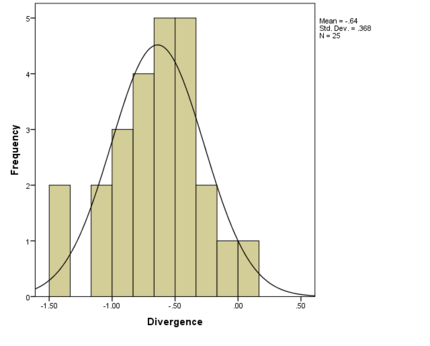Week 6 Individual Journal William P Fuchs
Assignment 6
Purpose
- To find the env gene's divergence and diversity and to correlate its diversity to CD4 count. Portion of this journal focuses on subject 9 across all visits and clones. Collaboration of the project in regards to subjects 6,8 and 14 carried out by group members and extended project scope covered by outline and presentation. This study in general is a reassessment of data points presented in the Markham et al. paper in terms of divergence and CD4 cell decline.
Methods
- Due to the scope of the project. Delegation of one subject's data to each member was appropriate.
- Run ClUSTALW multiple sequence alignment and calculate θ and diversity by subtracting the prior diversities from each visit interval (V2-V1(θ))
- Retrieve CD4 counts for each target subjects at each visit.
- Once all data was compiled, divergence was calculated through the formula: Divergence = ([|(θ2-θ1)/θ1|]/time). The resulting data was run against CD4 count to discover correlations (Pearson Correlation Test).
- To assist in the visualization of relationships between the strains several rooted trees were constructed but only subject 9's tree is included in this entry.
- To determine if the data distribution was within normality the ShapiroWilk for normality statistic (sample size <50) was conducted.
The CD4 T cell data was collected from the Markham et al. 1998 data table (online).
- The SPSS Statistics 21 program was utilized for all statistical analysis and generated figures.
- Findings and progression of the project assembled in a power point presentation.
- Pertinent figures generated are found in the "Data and Files" section.
Results/Scientific Conclusion
- After examining the theta values over time and reasoning with the raw divergence and CD4 cell count there seemed to be an existence of an indirect correlation between the two levels. However after running the Pearson correlation test, it was found that no significant correlation between divergence and CD4 count existed, contrary to the Markham et al. 1998 paper which presented a correlation relationship between the two across all their subjects. This may have potentially occurred because their sample size was larger and any local divergence fluctuations between each individual may have become negligible in the mathematical compounding of data. In regards to this study that the values found were within normal distribution and no outstanding significant difference was found.
Data and Files
ClustalW Dendrogram
Divergence and CD4 T cell Histograms for all Subjects


Test for Normality Result Table

Statistical Analysis Subject 9

Outline Power Point Powerpoint Link
References
- Markham, R.B., Wang, W.C., Weisstein, A.E., Wang, Z., Munoz, A., Templeton, A., Margolick, J., Vlahov, D., Quinn, T., Farzadegan, H., & Yu, X.F. (1998). Patterns of HIV-1 evolution in individuals with differing rates of CD4 T cell decline. Proc Natl Acad Sci U S A. 95, 12568-12573. [PDF].
- BEDROCK HIV Problem Space
- Workbench ClustalW Tool
- Assignment for Week 6: Rubric/instructions for this assignment.
Acknowledgements
The following group: Anindita Varshneya, Mia Huddleston worked and processed subjects 6 and 8 data across all visits and provided the diversity values needed to produce divergence and theta values. Colin Wikholm generated the histograms for divergence and CD4-T cell count and we communicated over social media for the construction of the power point presentation. While I worked with the people noted above, this individual journal entry was completed by me and not copied from another source. William P Fuchs 21:47, 10 October 2016 (EDT)
Journals and Weekly Assignments
Individual Journals
- WPF Week 2
- WPF Week 3
- WPF Week 4
- WPF Week 5
- WPF Week 6
- WPF Week 7
- WPF Week 8
- WPF Week 9
- WPF Week 10
- WPF Week 11
- WPF Week 12
- WPF Week 14
- WPF Week 15
Class Journals
- Week 1
- Week 2
- Week 3
- Week 4
- Week 5
- Week 6
- Week 7
- Week 8
- Week 9
- Week 10
- Week 11
- Week 12
- Week 13
- Week 14
- Week 15
Assignments
Useful Links
- Bio Class Page
- BIOL368/F16:People
- Will Fuchs
- Link to LMU: http://www.lmu.edu/